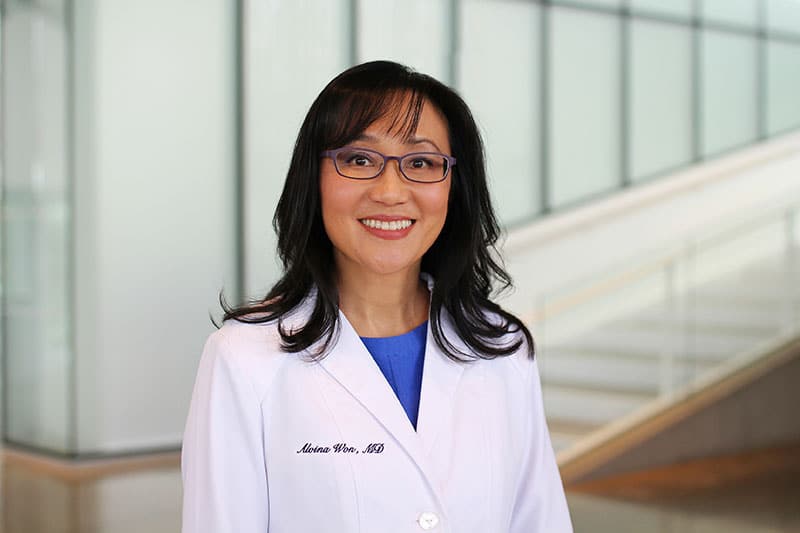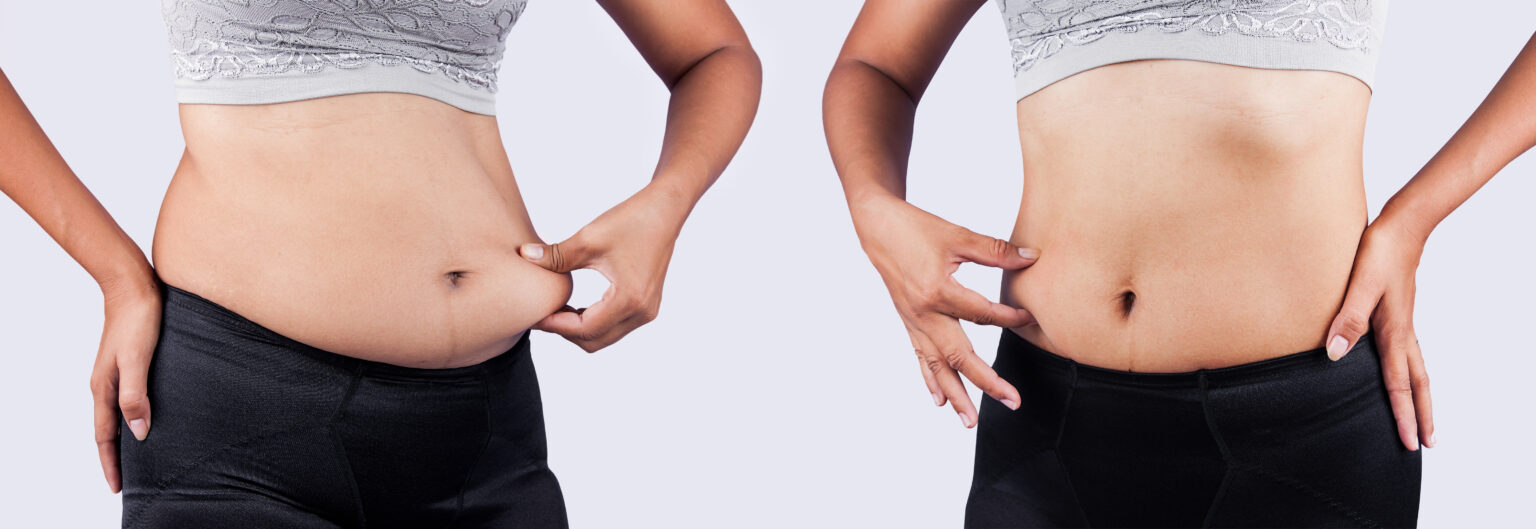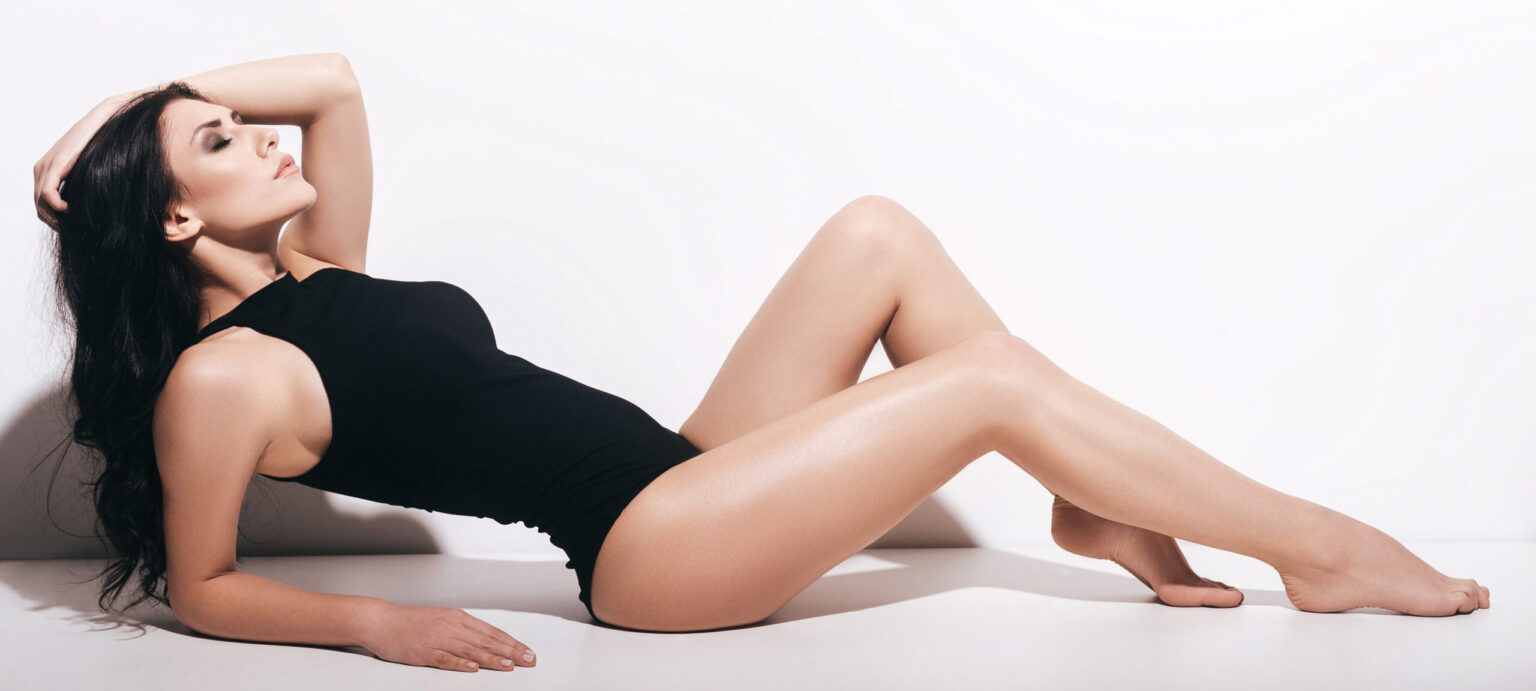A More Shapely You!
Body contouring, body sculpting and body lifts, refer to cosmetic surgery procedures that improve the shape of your body, such as tummy tucks, liposuction, arm lift, thigh lift, buttocks enhancement and more. It’s a way to address issues that cannot be corrected with diet and exercise, such as sagging skin after weight loss or pregnancy. It’s also a way to change aspects of your body that have been stubborn and unchanging, to bring about a more beautiful you.
- Tummy Tuck (Abdominoplasty), Fleur de Lis Abdominoplasty and Panniculectomy
- Liposuction
- Buttocks Enhancement
- Full Body Lift
- Posterior Body Lift (buttocks area)
- Brachioplasty (arm lift)
- Thighplasty (thigh lift)
- Gynecomastia Surgery (for men with excess breast tissue)
Abdominoplasty (Tummy Tuck)
An Abdominoplasty, or Tummy Tuck, as it’s more commonly called, is done to remove excess skin and fat in the abdominal area. Additionally, muscles that have weakened or separated can be tightened resulting in an abdominal appearance that is not only smoother, but also much firmer.
Some common causes of a protruding or sagging abdomen include:
- Heredity
- Pregnancy
- Fluctuations in weight
- Aging
A tummy tuck requires a horizontal u-shaped incision that goes from side to side between the belly button and the pubic bone. This scar will fade over time and is not visible when wearing underwear or a bathing suit. (If you have had a prior cesarean section, scars from this may be incorporated into the new scar). Once the incision is made, the abdominal skin is lifted and any excess is cut away. The underlying abdominal muscles are also repaired.
Next, the upper abdominal skin is pulled down and any excess skin is removed. The remaining skin is sutured together. The belly button may need to be repositioned which requires creating a new opening, and then the belly button is pulled through to the surface and sutured into the correct position. Thin tubes may be placed under the skin in order to drain any fluid or blood that may collect after the procedure. These are usually removed after 1 – 2 weeks.
After surgery, you will be required to wear a pressure garment around your abdominal area for 4-6 weeks as you heal. The scar will take several months to fade. Dr. Won will advise you of what to expect during your recovery period, how to care for your wound, and when you can resume normal activities. You should see some immediate results after your surgery, though swelling and bruising is to be expected, however this should begin to subside within a few weeks.
Fleur de Lis Abdominoplasty
With a “regular” type tummy tuck, you will only have one u-shaped scar that is located between the belly button and pubic bone as described above. A Fleur de Lis Abdominoplasty has incisions that resemble the shape of the French signet. In addition to having an incision that runs horizontally across the abdomen, you will also have a vertical incision that goes up the center of your abdomen. The combination of the horizontal and vertical scar look like an upside down T.
This type of tummy tuck is used when there is significant excess skin across the entire midsection of the body. This procedure is popular for patients who have lost a significant amount of weight and will reveal their slim figures that have been hiding under a lot of excess skin. The results are a tummy that is as flat as it can be.
Regardless of the type of Abdominoplasty that you choose, if you gain weight or become pregnant again, it is possible that the results of the tummy tuck will not last, so Dr. Won does not recommend Abdominoplasty if you plan to have more children.
Recovery is similar to a standard Abdominoplasty. After surgery, you will be required to wear a pressure garment around your abdominal area for 4 – 6 weeks as you heal. The scar will take several months to fade. Dr. Won will advise you of what to expect during your recovery period, how to care for your wound, and when you can resume normal activities. You should see some immediate results after your surgery, though swelling and bruising is to be expected, however this should begin to subside within a few weeks.
Panniculectomy
The excess skin and fat in the lower abdominal area that hangs down like an “apron” is called a pannus, and can have negative effects on quality of life. The extra fold or folds of skin can hinder hygiene, put stress on the back, and make everyday activities difficult.
Often, the area in the pubic region under the pannus can become moist as perspiration is trapped. This can cause skin irritation, rashes, recurrent infections, and odor, a condition called “intertrigo.” Clothing may not fit comfortably, and if severe, even simple activities such as bending over or walking can become difficult.
People who have lost a large amount of weight and are experiencing negative side effects due to excess skin in the abdominal area are good candidates for panniculectomy. It is best to have had stable weight for at least six-months, and for women, should not be planning to have further pregnancies. Some, or all of the costs of surgery may be covered by insurance.
Unlike an abdominoplasty, a panniculectomy does NOT tighten muscles or reposition the belly button. It only removes the excess skin and fat of the pannus, using a horizontal incision that runs from hip to hip. Drains are placed to help prevent collections of fluid or blood and are removed after 1 – 2 weeks.
As with other abdominal surgeries, most people require at least two weeks off from work but need to wait at least six weeks before resuming to normal activities. The first week after panniculectomy is the most uncomfortable due to swelling and bruising, but gets better with time. Patients are required to wear a compression garment for a total of 6 weeks after surgery, around the clock for the first 4 weeks, then only during active parts of the day for an additional two weeks.
Liposuction
Liposuction is a procedure that utilizes a suction technique to remove fat from specific areas of the body which can include hips, abdomen, thighs, arms, or buttocks. Liposuction is also used to shape, or contour, these areas. Liposuction is not a weight loss procedure; it is used to remove small pockets of fat. It’s also used as a part of other procedures such as a body lift or posterior lift, etc. For example, if you are having a thigh lift, incisions are made which will tighten the skin, but liposuction will also be used to remove some of the fat in conjunction with tightening the area.
If you have a stable body weight, liposuction can be used to suction stubborn areas of fat in specific areas where dieting and exercise is not going to make a difference. These areas can include:
- Abdomen
- Thighs
- Hips
- Buttocks
- Upper arms
- Chest
- Back
Liposuction is also used in breast reduction surgeries and treatment for gynecomastia in men.
Gaining weight causes both an increase in the number of fat cells in a particular area, and also an increase in the size of the fat cells. Liposuction can help to reduce the amount of fat cells that are contained in specific areas. However, liposuction does not remove stretch marks or improve cellulite.
Ideally, after having the liposuction procedure, your skin should “mold” itself to the new shape of the areas that have been treated if your skin still has plenty of elasticity. However, if your skin has thinned or lost its shape, it’s possible that skin will appear to be loose in the affected areas. In cases like these, additional procedures can be performed in conjunction with the liposuction which will tighten the skin up so it better conforms to the new shape. When you have your consultation with Dr. Won, she can advise you of which procedures would work best for you to achieve the results you desire.
After your procedure, you can expect some swelling and bruising. Temporary drainage tubes may be placed in the treated areas to promote fluid drainage, and you will need to wear compression garments during your healing process. It will also take a few weeks for the remaining fat to settle into its new position. You can usually return to work after a few days to a few weeks, depending on the extent of your procedure. Dr. Won will go over what to expect during your specific recovery.
Buttocks Enhancement Through Fat Transfer
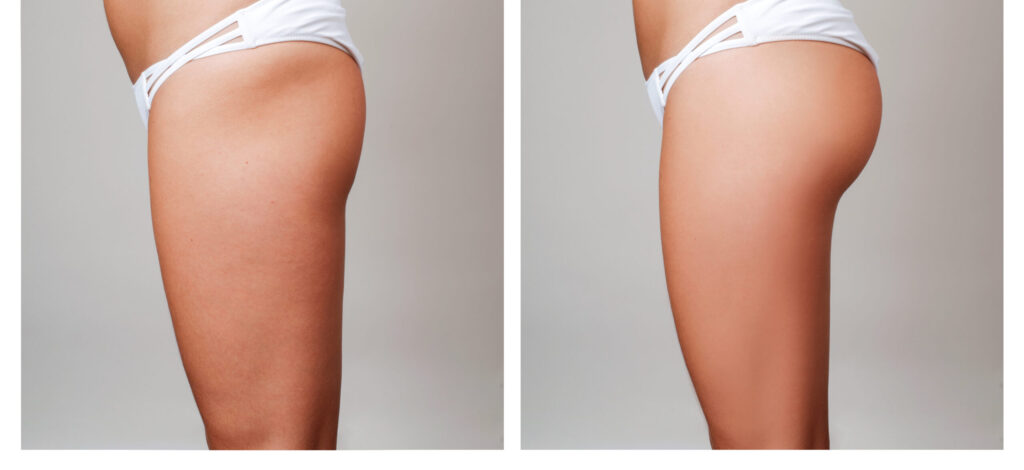
Diet and exercise can certainly help to maintain a healthy weight and to keep the body toned, but a lot of women still have flatter buttocks without much shape and exercise is not going to change that.
A Buttocks enhancement through fat transfer is a cosmetic surgical procedure that can reshape the buttocks and provide you with more curve and shape. It also helps to provide more balance between the upper and lower body.
In this procedure, liposuction is used to take fat from other parts of the body such as the belly, hips, or thighs and transferred to the buttocks area to add more volume and shape. Not only will this provide shape to the buttocks, it can also reduce fat pockets on the area(s) where the fat is taken from.
Once fat is extracted from another part of the body, it is purified and prepared for transfer, and then injected into specified points on the buttocks which will improve shape and increase volume.
While this procedure does add more volume and shape, ideally you need to have good skin tone and elasticity for the skin to mold to the fat. If you have a lot of sagging skin on your buttocks, a posterior (butt) lift can also be done simultaneously to provide optimal results.
Dr. Won is an accredited cosmetic surgeon and has been specially trained for this procedure. You can learn more about the risks, costs, and what to expect during recovery at the time of consultation with Dr. Won.
Body Lift
A body lift is recommended for those who would like to tighten loose skin around the abdominal area (sides or lower back), buttocks or thighs. Aging, genetics, pregnancy or significant weight fluctuation can cause weakened tissue elasticity and sagging skin. A body lift is designed to shape and contour the patient’s body, focusing on solving poor skin elasticity.
A body lift cannot be used in place of weight loss. You should be at, or near your goal weight before considering a body lift. Liposuction can be used to remove small, excess fatty deposits when skin elasticity is good, however, when it is poor, body lift techniques used in conjunction with liposuction are used. Body lift surgery is generally used to address loose and hanging skin. This can occur as a result of pregnancy, age, or a big weight loss.
The body lift procedure is meant to raise, firm, and tighten the skin of the buttocks, thighs, groin, abdomen, and waist. This procedure is also called a “belt lipectomy” because the incisions encircle the body like a belt would. The tissues are repositioned and skin is tightened to create a more aesthetically pleasing contour. Dr. Won will work to place the incision(s) as inconspicuously as possible so that it will not be visible when wearing underwear or a bathing suit. Scars will improve as time goes by, but can take up to 1 – 2 years to fade.
Recovery time varies based on the extent of the procedure that you have done. Generally, it takes 4 – 6 weeks until you can resume normal activities.
Posterior Body Lift
This type of procedure is used to eliminate excess skin that is often left after losing large amounts of weight. It is NOT a weight loss procedure, but rather a way to eliminate loose skin that is inelastic and make for a more pleasing aesthetic appearance to show off your weight loss!
It is designed to address areas such as the hips, love handles, and the buttocks. It will give your body and skin a more smooth and youthful appearance. Liposuction can be used to eliminate small fatty deposits.
The recovery period usually lasts 4-6 weeks before you will be able to return to normal activities. Initially, you will have drains in place so that no fluid or blood accumulates. Additionally, you will be required to wear compression garments for a period of 4 – 6 weeks. Initially, there will be bruising and swelling, but this will subside over time. Dr. Won will advise you of exactly what to expect and watch for throughout your recovery, specific to the surgery that you have.
Thigh Lift (Thighplasty)
Dr. Won performs medial thigh lifts which include an incision in the groin area and may include an incision down the inner thigh depending on how much excess tissue the patient has. The tissue is shaped and tightened while the skin is lifted and smoothed.
Thigh lift surgery is NOT a surgical weight loss procedure. It is used to tighten and improve the appearance of the thighs due to excess skin which may result from pregnancy, weight loss, or aging. Thighs can also take on a dimpled or flabby appearance. The thighplasty will both lift and contour the thighs so that they look more smooth, thin, and toned. Liposuction is often used during a thigh lift to remove small excess areas of fat.
Recovery is similar to other types of body lifts. There will be bruising and swelling initially and temporary drains will be inserted so that fluid and blood does not accumulate during recovery. You can usually return to work within about 10 days depending on the extent of the procedure that you have, and return to normal activities within 4 – 6 weeks. The scars associated with a thigh lift are usually hidden in the body’s natural creases.
Brachioplasty (Arm Lift)
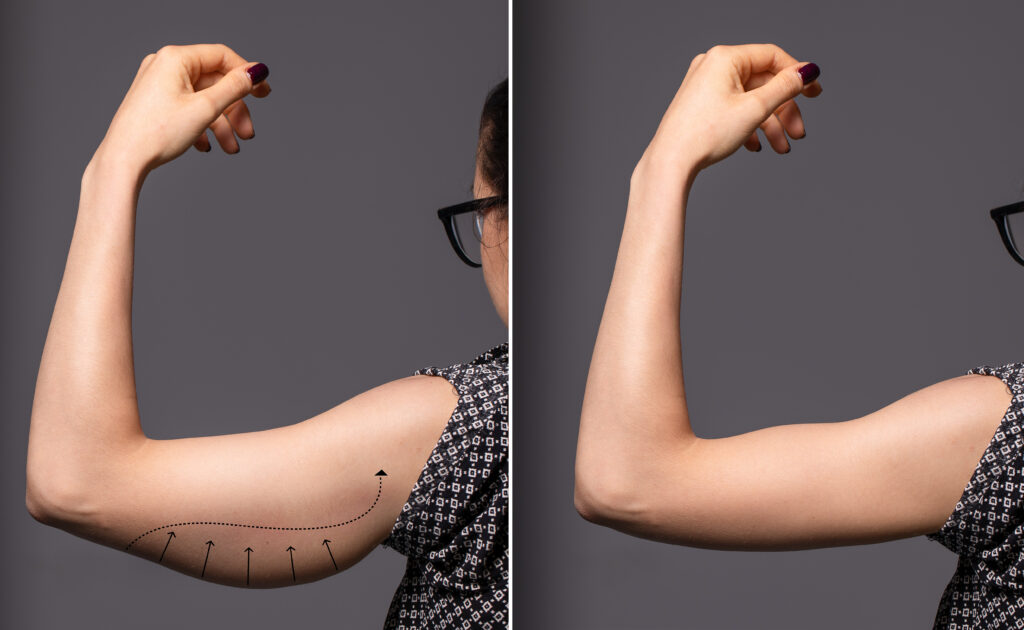
An arm lift procedure can:
- Reduce sagging skin
- Smooth and tighten the tissue that shapes the upper arm
- Reduce small pockets of fat in the upper arm
The length of the incision will be determined based on the extent and location of the excess skin that is being removed. Excess pockets of fat can be removed with liposuction. The incision is usually placed either on the inside of the arm or on the backside of the arm where it will be less visible.
If minimal contouring is needed, it’s possible that the incision can be placed in the armpit area. Depending on the extent of your particular condition, it’s not always possible to get optimal results with just one surgical procedure, and a second may be needed. The results of this type of surgery are long-lasting if you maintain a stable weight and overall good general fitness. As you grow older, it is possible to lose some degree of firmness, however overall the results should be permanent.
Gynecomastia surgery (for men with excess breast tissue)
Gynecomastia is a condition that causes men to develop enlarged breast tissue. It can affect men of all ages, including teens who are going through puberty. There are different things that can cause gynecomastia such as underlying hormonal imbalances or health conditions and side-effects from some drugs. In some cases, the cause is unknown. It is possible that gynecomastia can go away on its own, or after any underlying health condition is resolved, however in over 25% of cases, it doesn’t resolve.
Many men are embarrassed by this condition, especially when they are in situations that involve taking off their shirts such as being at the pool or the gym. Depending on the severity of the breast enlargement, clothing doesn’t always hide the condition. Some try diet and exercise to try and reduce the breast size without success.
Mild cases of gynecomastia may be able to be corrected with liposuction alone. However, in more severe cases, the breast tissue and loose skin needs to be excised. When this is needed, the nipples can also be repositioned so they are in the correct placement relative to the new chest shape.
During surgery, the excess breast tissue and fat is removed, but the pectoralis muscles are left in place so that they will be more visible after the surgery is completed. After the recovery process, men will still be able to use exercise to strengthen and tone the chest muscles to enhance their masculine form.
Gynecomastia surgery is not recommended for teens until they have finished going through puberty since it’s possible that it could return after surgery. For men at any age, it’s important to see a doctor to determine what has caused the condition so that can be addressed as well.
Dr. Won is a Board-certified cosmetic surgeon and is experienced in this type of procedure. During your consultation, she will answer all of your questions and explain costs, risks, and what to expect from surgery and recovery.
Are you a Candidate for Cosmetic Surgery?
Not everyone is a candidate for cosmetic surgery. If you are in the process of losing weight, it is best to wait until you have reached your goal weight before undergoing any kind of cosmetic procedure. Additionally, if you are still planning on having children, it is best to wait until you have had your child and recovered from the pregnancy. The reason for this is because weight fluctuations can affect the long-lasting benefits that are gained from having cosmetic surgery. Additionally, if you are currently a smoker, you will need to stop completely prior to undergoing any type of procedures since smoking can affect both the healing process and the results gained from a procedure. Also, it is important that you have a positive attitude and a realistic outlook about what surgery can do for you. An unhealthy lifestyle and poor overall health and fitness can wreak havoc on your appearance.


